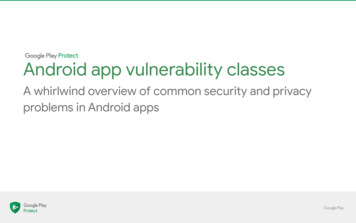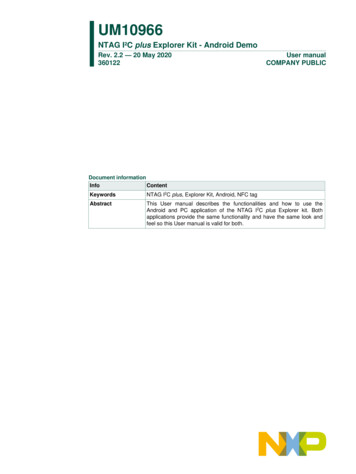
Transcription
Android app vulnerability classesA whirlwind overview of common security and privacyproblems in Android apps
IntroductionHow Google Play Protect educates developers to makemillions of apps safer to use
Content of the presentation Overview of common Android app vulnerabilities reportedthrough the Google Play Security Rewards Program Explicitly not an attempt at creating a complete audit guide Focused only to vulnerabilities in scope for our bug bounty For each vulnerability present OverviewAuditing tipsRemediation tipsCWE ID (Common Weakness Enumeration) and other resources
How to use this presentation You are an app developer: Understand which severe vulnerabilities are common even in topapps by top developersLearn how to find more information about how to identify and fixthese vulnerabilities You are a security researcher: Understand what common vulnerabilities are worth looking intoLearn how to find these vulnerabilities to earn your own bugbounties
Android app vulnerabilities19 vulnerability classes across 5 themes
Insecure connections
Use of insecure network protocolsThe problem: Loading data over insecure networks such as HTTP allows attackers that control thenetwork (for example a local WiFi network) to replace, remove, and inject code.Example codeURL url new URL("http://www.google.com");HttpURLConnection urlConnection (HttpURLConnection) Stream in urlConnection.getInputStream();See also: CWE-319 (Cleartext Transmission of Sensitive Information)
Use of insecure network protocolsThe problem: Loading data over insecure networks such as HTTP allows attackers that control thenetwork (for example a local WiFi network) to replace, remove, and inject code.Auditing tips Review the app’s network security configuration (an Android P feature) to understandwhether app is allowed to use insecure network protocols in the first place. curity-config (“Networksecurity configuration”)Grep the app’s code for “http:”, “ftp”, “smtp:”, and URLs that indicate use of insecurenetwork protocols.Understand common entry points into the network such as the URL class or theWebView class and check whether there are code flows that lead to insecureconnections being made.
Use of insecure network protocolsThe problem: Loading data over insecure networks such as HTTP allows attackers that control thenetwork (for example a local WiFi network) to replace, remove, and inject code.Remediation Apps targeting Android P and above are safe by default. If such apps still want tomake insecure connections, they have to define a network security configurationthat allows that.Use javax.net.ssl.HttpsURLConnection as much as possible.Presubmit checks to look for URLs for insecure protocols are easy to set up.The Android Lint check InsecureBaseConfiguration flags insecure HTTPconnections.
Data transmission over insecure protocolsThe problem: Sending sensitive data over insecure networks such as HTTP allows attackers thatcontrol the network (for example a local WiFi network) to intercept, modify, and steal the data.Example codeURL url new URL("http://www.mysite.com?lookupNumber " phoneNumber);HttpURLConnection urlConnection (HttpURLConnection) Stream in urlConnection.getInputStream();See also: CWE-319 (Cleartext Transmission of Sensitive Information)
Data transmission over insecure protocolsThe problem: Sending sensitive data over insecure networks such as HTTP allows attackers thatcontrol the network (for example a local WiFi network) to intercept, modify, and steal the data.Auditing tips In addition to the auditing tips for finding the use of insecure network protocols: Understand which user data and application data is potentially sensitive Audit whether any network connections over insecure protocols sendpotentially sensitive data to network endpoints
Data transmission over insecure protocolsThe problem: Sending sensitive data over insecure networks such as HTTP allows attackers thatcontrol the network (for example a local WiFi network) to intercept, modify, and steal the data.Remediation Exactly the same as for the use of insecure network connections
Authentication over insecure protocolsThe problem: Sending login information over insecure networks such as HTTP allows attackers thatcontrol the network (for example a local WiFi network) to intercept, modify, and steal the data.Example codeURL url newURL("http://www.mysite.com?user bugdroid&pwd androidnumberone");HttpURLConnection urlConnection (HttpURLConnection) Stream in urlConnection.getInputStream();See also: CWE-319 (Cleartext Transmission of Sensitive Information)
Authentication over insecure protocolsThe problem: Sending login information over insecure networks such as HTTP allows attackers thatcontrol the network (for example a local WiFi network) to intercept, modify, and steal the data.Auditing tips In addition to the auditing tips for finding the use of insecure network protocols: Understand which login information the app is working with Audit whether any network connections over insecure protocols send logininformation to network endpoints
Authentication over insecure protocolsThe problem: Sending login information over insecure networks such as HTTP allows attackers thatcontrol the network (for example a local WiFi network) to intercept, modify, and steal the data.Remediation In general the same as for the use of insecure network connections.Authentication should probably be handled through a common, security-vettedmethod such as OAuth. Custom authentication schemes are likely to get more wrongthan just insecure network protocols.
Cryptography and authentication
Embedded third-party secretsThe problem: Apps that embed third-party secrets such as Twitter API keys or AWS authenticationtokens can trivially have these secrets extracted and abused by attackers.Example codeParseTwitterUtils.initialize("CONSUMER KEY", "CONSUMER SECRET");flag{a0a6cb3b4bc98bf2a34b7aed76aebf53}See also: CWE-798 (Use of Hard-coded Credentials)
Embedded third-party secretsThe problem: Apps that embed third-party secrets such as Twitter API keys or AWS authenticationtokens can trivially have these secrets extracted and abused by attackers.Auditing tips Compile a list of interesting public APIs and create regular expressions to find keys orsecrets through grep.Compile a list of interesting public APIs and look for their package names in apps.Grep for “key”, “password”, “login”, “secret” and such.
Embedded third-party secretsThe problem: Apps that embed third-party secrets such as Twitter API keys or AWS authenticationtokens can trivially have these secrets extracted and abused by attackers.Remediation Follow best practices for the used API as documented in their help center. Some APIs encourage you to embed their secrets in the app as a secretcompromise will have limited negative effects.Some third-party services offer more secure alternatives to embedding credentialsin the app (such as Amazon and Google) while others like Twitter considerembedding the third-party secrets in the code as best practice. For services which don’t provide a per-user authentication service, it’s possibleto spin up your own server that handles this.For services that recommend embedding third-party secrets in the app, expect thesecrets to be extracted and abused by attackers. The goal for such situations is tomitigate the negative effects of the abuse.
Embedded cryptography secretsThe problem: Applications that use embedded crypto secrets are susceptible to simple datadecryption attacks.Example codeprivate static String SECRET KEY "MySecretAESKey99";private static byte[] encrypt(String inputText) throws Exception {Cipher cipher init(Cipher.ENCRYPT MODE,new SecretKeySpec(SECRET KEY.getBytes(), "AES"));return cipher.doFinal(inputText.getBytes("UTF-8"));}See also: CWE-321 (Use of Hard-coded Cryptographic Key)
Embedded cryptography secretsThe problem: Applications that use embedded crypto secrets are susceptible to simple datadecryption attacks.Auditing tips Look for all uses of APIs in the javax.crypto packageLook for all embedded popular cryptography librariesAudit initialization and use of discovered cryptography APIs
Embedded cryptography secretsThe problem: Applications that use embedded crypto secrets are susceptible to simple datadecryption attacks.Remediation Understand what you are trying to protect from whom In many cases using embedded secrets is actually fineAvoid rolling your own crypto by abstracting what you’re trying to do and using aready-made library for your purpose
Leaking OAuth tokensThe problem: OAuth Implicit Grant and Authz (without PKCE) flows expose tokens that can be usedto create fraudulent requests.Example codeString url "https://accounts.google.com/o/oauth2/v2/auth";url "?client id XXXX";url "&redirect url com%2Emy%2Eapp%3A%2F%2Foauth";url "&response type token"; // Use Implicit Grant (url "&scope email";Intent i new Intent(Intent.ACTION VIEW, Uri.parse(url));startActivity(i);See also: CWE-? (?)
Leaking OAuth tokensThe problem: OAuth Implicit Grant and Authz (without PKCE) flows expose tokens that can be usedto create fraudulent requests.Auditing tips Search for OAuth endpoint URLs being sent to the browser and check whatparameters are being passed Implicit grant is always bad If using Authz flow, check for PKCE use If using PKCE, check that it is not predictable
Leaking OAuth tokensThe problem: OAuth Implicit Grant and Authz (without PKCE) flows expose tokens that can be usedto create fraudulent requests.Remediation Use a platform-integrated authentication flow rather than the browser. Much more foolproof.If using OAuth in the browser, use the Authz flow with PKCE Make sure you aren’t using a hardcoded secret or nonce
Private file access
Private data sharingThe problem: Applications may leak private data to other apps or attackers in obvious and subtleways.Example codepublic class FileUploader extends Activity {protected void onCreate(Bundle savedInstanceState) {String path ng url dFile(path, url);}}See also: CWE-359 (Exposure of Private Information ('Privacy Violation'))
Private data sharingThe problem: Applications may leak private data to other apps or attackers in obvious and subtleways.Auditing tips Look for files stored on external storage which is world-readable by default.Look for files stored in internal storage whose access attributes are changed to makethem world-accessible.Look for unsanitized file or path names that are supplied by potential attackers.
Private data sharingThe problem: Applications may leak private data to other apps or attackers in obvious and subtleways.Remediation Store files in internal storage with default access attribute unless you want tointentionally share them with other apps.Limit the ability of users to supply their own path or file names.Verify that the canonical path of a file or path points to an expected path. Watch out for TOCTOU issues. Symlinks can change at any time.
Private data overwrite due to path traversalThe problem: Applications that don’t sanitize attacker-provided directory paths may be susceptibleto overwrite their internal files with attacker-provided files.Example codeOutputStream os new FileOutputStream(PUBLIC DIRECTORY "/Download/" filename);See also: CWE Category 21 (Pathname Traversal and Equivalence Errors)
Private data overwrite due to path traversalThe problem: Applications that don’t sanitize attacker-provided directory paths may be susceptibleto overwrite their internal files with attacker-provided files.Auditing tips Find any kind of path or file operations with variable input and see if they rely onuser-provided input.
Private data overwrite due to path traversalThe problem: Applications that don’t sanitize attacker-provided directory paths may be susceptibleto overwrite their internal files with attacker-provided files.Remediation Limit the ability of users to supply their own path or file names.Verify that the canonical path of a file or path points to an expected path right beforedoing file operations on the file or path.
Private data overwrite due to ZIP file traversalThe problem: Applications that unzip archive files without sanitizing the target file paths of filesinside the archives are susceptible to overwriting their internal files with attacker-provided files.Example codeInputStream is new FileInputStream(zipFilePath);ZipInputStream zis new ZipInputStream(new BufferedInputStream(is));ZipEntry ze;while ((ze zis.getNextEntry()) ! null) {outputFileName ze.getName();writeToFile(outputFileName, zis);}See also: CWE ? (?)
Private data overwrite due to ZIP file traversalThe problem: Applications that unzip archive files without sanitizing the target file paths of filesinside the archives are susceptible to overwriting their internal files with attacker-provided files.Auditing tips Find all uses of APIs in the java.util.zip.* package or third-party zipping libraries.Understand whether user-provided ZIP files are being unzipped by the code.
Private data overwrite due to ZIP file traversalThe problem: Applications that unzip archive files without sanitizing the target file paths of filesinside the archives are susceptible to overwriting their internal files with attacker-provided files.Remediation Validate that the canonical path of unzipped files points to the real directory to unzipto. A Google search for “android zip path traversal” will lead to examples.
Unprotected app parts
Unprotected activitiesThe problem: Exported activities can be started by other apps on the device which may break userworkflow assumptions, including ways that break security boundaries.Example code activity android:name "com.mypackage.SomeActivity" . intent-filter action android:name "com.mypackage.OPEN" / category android:name "android.intent.category.DEFAULT" / /intent-filter . /activity See also: CWE-926 (Improper Export of Android Application Components)
Unprotected activitiesThe problem: Exported activities can be started by other apps on the device which may break userworkflow assumptions, including ways that break security boundaries.Auditing tips Understand what conditions can lead to activities being exported android:exported attribute Presence of intent filters auto-exports activitiesGo through list of activities declared in manifest XML file Find those that are exported
Unprotected activitiesThe problem: Exported activities can be started by other apps on the device which may break userworkflow assumptions, including ways that break security boundaries.Remediation Explicitly mark components with android:exported "false" in the application manifestUse android:protectionLevel "signature" in the xml manifest to restrict access toapplications signed by you
Unprotected servicesThe problem: Applications that export services allow malicious apps on the device to start thoseservices.Example code service android:name "com.myapp.service" . intent-filter action android:name "com.myapp.START SERVICE" / /intent-filter . /service See also: CWE-926 (Improper Export of Android Application Components)
Unprotected servicesThe problem: Applications that export services allow malicious apps on the device to start thoseservices.Auditing tips Same as for unprotected activities
Unprotected servicesThe problem: Applications that export services allow malicious apps on the device to start thoseservices.Remediation Same as for unprotected activities
Typos in custom permissionsThe problem: When used custom permissions don’t match declared custom permissions, Androiddefaults to silently failing to enforce the permission.Example code permissionandroid:label "@string/write contact permission"android:name "my.app.permission.write" / provider android:label "@string/contacts"android:name "my.app.ContactsProvider"android:writePermission "my.app.permissions.write"/ See also: CWE-? (?)
Typos in custom permissionsThe problem: When used custom permissions don’t match declared custom permissions, Androiddefaults to silently failing to enforce the permission.Auditing tips For stand-alone applications, check that declared and used permissions match in themanifest file. For sets of apps, check that declared and used permissions match across thewhole set of apps.
Typos in custom permissionsThe problem: When used custom permissions don’t match declared custom permissions, Androiddefaults to silently failing to enforce the permission.Remediation If you are using custom permissions you can set up a presubmit check to seewhether any declared permissions are not used or any used permissions areundeclared. Doesn’t quite work if you have multiple interacting apps where not all appsdeclare and use the same permissions. Maybe a whitelist in the presubmitcheck is possible.
Intent redirectionThe problem: Apps that accept and launch arbitrary intents from external sources may allowmalware to start internal components indirectly or access protected content:// URIs.Example codeprotected void onHandleIntent(Intent intent) {if (intent ! null) {Intent privateIntent new Intent(this, ent);}}See also: CWE-925 (Improper Verification of Intent by Broadcast Receiver)
Intent redirectionThe problem: Apps that accept and launch arbitrary intents from external sources may allowmalware to start internal components indirectly or access protected content:// URIs.Auditing tips Find calls to startActivity and verify that Intent components are constructed fromtrusted data.Find calls Intent::getExtras where returned values are cast to Intent and verify thatthey are properly checked before being used. It isn’t enough to check the target class name. Malware can reuse your classnames and force your app to send an Intent that grants content:// URI access totheir app.
Intent redirectionThe problem: Apps that accept and launch arbitrary intents from external sources may allowmalware to start internal components indirectly or access protected content:// URIs.Remediation Whenever sending an Intent created from untrusted data Check the class name and package name of the target component or Check the signing key of the app that owns the target component Verify that Intents don’t contain FLAG GRANT READ URI PERMISSION orFLAG GRANT WRITE URI PERMISSION
Implicit broadcasts (sending)The problem: Applications that send broadcasts without specifying the broadcast target may havethese broadcasts intercepted by malicious apps on the same device.Example codeandroid.content.Intent intent new android.content.Intent();intent.putExtra("SMS", setClass(context, my.app.SmsHandler);sendBroadcast(intent);See also: CWE-927 (Use of Implicit Intent for Sensitive Communication)
Implicit broadcasts (sending)The problem: Applications that send broadcasts without specifying the broadcast target may havethese broadcasts intercepted by malicious apps on the same device.Auditing tips Look for all intent broadcasts that do not have a target set Called implicit broadcasts Lacks setComponent, setClass, setClassName or an explicit constructor
Implicit broadcasts (sending)The problem: Applications that send broadcasts without specifying the broadcast target may havethese broadcasts intercepted by malicious apps on the same device.Remediation Turn as many implicit intents into explicit intents.For the intents that cannot be made explicit understand that they can be intercepted Think through the worst case scenarios. Document why these intents are implicit.
Implicit broadcasts (receiving)The problem: Applications that accept broadcasts without checking the sender may acceptmaliciously crafted broadcasts sent from malicious apps on the same device.Example codefinal class Receiver extends BroadcastReceiver {public final void onReceive(Context ctx, Intent intent) {if (verifyPackageName(getCallingActivity())) {doSomethingSecret();}}}Don’t actually know what verifyPackageName would look like.See also: CWE-925 (Improper Verification of Intent by Broadcast Receiver)
Implicit broadcasts (receiving)The problem: Applications that accept broadcasts without checking the sender may acceptmaliciously crafted broadcasts sent from malicious apps on the same device.Auditing tips Find all receivers in the app Look at manifest file and for Context.registerReceiver calls. Non-exported receivers are safe as they can only receive broadcasts frominside the app.
Implicit broadcasts (receiving)The problem: Applications that accept broadcasts without checking the sender may acceptmaliciously crafted broadcasts sent from malicious apps on the same device.Remediation Make as many receivers as possible non-exported.For receivers that have to stay exported, treat all inputs as untrusted.
OtherEverything else that doesn’t fit anywhere
Incorrect URL verificationThe problem: Apps that rely on URL parsing to verify that a given URL is pointing to a trusted servermay be susceptible to many different ways to get URL parsing and verification wrong.Example code// Just one of many ways to get URL verification wrongif (uri.getHost().endsWith("mywebsite.com")) {webView.loadUrl(uri.toString());}See also: CWE-939 (Improper Authorization in Handler for Custom URL Scheme)
Incorrect URL verificationThe problem: Apps that rely on URL parsing to verify that a given URL is pointing to a trusted servermay be susceptible to many different ways to get URL parsing and verification wrong.Auditing tips Find every instance of URLs being used in an appNarrow it down to those that work on user-controlled inputNarrow it down to those that are used to branch between different code paths Could be any part of the URL, not just the host name
Incorrect URL verificationThe problem: Apps that rely on URL parsing to verify that a given URL is pointing to a trusted servermay be susceptible to many different ways to get URL parsing and verification wrong.Remediation Read and understand https://hackerone.com/reports/431002 “Golden techniques to bypass host validations in Android apps”Create a library that follows best practices and always use that when trying to verifyURLs
Cross-app scriptingThe problem: Apps that load untrusted URLs from other apps into their WebViews that match acertain form (e.g., javascript: or file:///path/to/private) allow malicious JavaScript code execution.Example codeIntent intent getIntent();String url intent.getStringExtra(“url”);WebView myWebview (WebView) findViewById(R.id.foo);// url points to the cookies database, is a javascript:// url, or is a phishing urlmyWebview.loadUrl(url);See also: CWE-925 (Improper Verification of Intent by Broadcast Receiver)
Cross-app scriptingThe problem: Apps that load untrusted URLs from other apps into their WebViews that match acertain form (e.g., javascript: or file:///path/to/private) allow malicious JavaScript code execution.Auditing tips Find calls to loadUrl and evaluateJavascript in your app.Verify that inputs to these functions are trusted or sanitized (or both).Check for dangerous WebView settings like setAllowFileAccess(true) Files can contain *both* malicious scripts and sensitive user data (the cookiesdatabase).
Cross-app scriptingThe problem: Apps that load untrusted URLs from other apps into their WebViews that match acertain form (e.g., javascript: or file:///path/to/private) allow malicious JavaScript code execution.Remediation Disable WebView file access unless it is needed. Use setAllowFileAccess(false)Target up-to-date SDK versions to prevent javascript: URLsMake sure that app-private Activities aren’t exported by accident Creating an intent-filter exports the component by default!Verify that URLs from external sources are safe to load before calling loadUrl() URL validation can be tricky as you just learned. Think carefully about what URLs are acceptable. Same-origin-policy does notprotect against phishing.
Incorrect sandboxing of scripting languageThe problem: Embedding a scripting language or interpreter in an app can lead to exposure of appinternals if the security boundaries of the interpreter are not well understood.Example codePythonInterpreter interpreter new PythonInterpreter();interpreter.exec("from shutil import copyfile\ncopyfile(\"passwords.bin\", \"/sdcard/passwords.bin\");See also: CWE-266 (Incorrect Privilege Assignment)
Incorrect sandboxing of scripting languageThe problem: Embedding a scripting language or interpreter in an app can lead to exposure of appinternals if the security boundaries of the interpreter are not well understood.Auditing tips Look for indicators of scripting languages Common interpreters such as Python inside the app. Interpreters may be hidden in file formats like PDF (Javascript). Look for Android and Java sandboxing libraries.Check whether these interpreters allow untrusted input.
Incorrect sandboxing of scripting languageThe problem: Embedding a scripting language or interpreter in an app can lead to exposure of appinternals if the security boundaries of the interpreter are not well understood.Remediation Disable user-supplied input if possible.Build your own limited-scope interpreter or interface to more permissiveinterpreters.Otherwise sanitize scripts, disable scripting, or restrict permissions and abilities ofinterpreter engine.
Unprotected data on serverThe problem: An app connects to a remote web server, database, or API that does not sufficientlyprotect sensitive user data. Any attacker can access this data.Example codeNot applicable since the problem is not in the applicationcode.See also: CWE-306 (Missing Authentication for Critical Function)
Unprotected data on serverThe problem: An app connects to a remote web server, database, or API that does not sufficientlyprotect sensitive user data. Any attacker can access this data.Auditing tips Find all instances of an app connecting out to a remote server, either in the main appor through SDKs.Understand default and custom configuration options for remote endpoints.Bug Bounty through the Google Play Security Reward Program: 0 (not in scope)
Unprotected data on serverThe problem: An app connects to a remote web server, database, or API that does not sufficientlyprotect sensitive user data. Any attacker can access this data.Remediation Follow best practices for your particular web host or API provider.
Q&AQuestions?Want to learn more about the Google Play SecurityReward rity/play-rewards/.?
THANKYOU
How Google Play Protect educates developers to make millions of apps safer to use Overview of common Android app vulnerabilities reported . Apps targeting Android P and above are safe by default. If such apps still want to make insecure connections, they have to define a network security configuration










